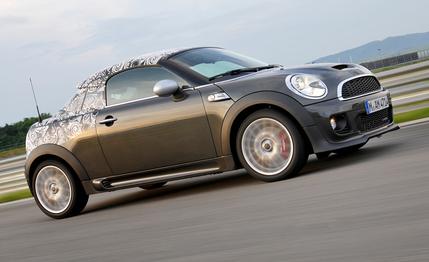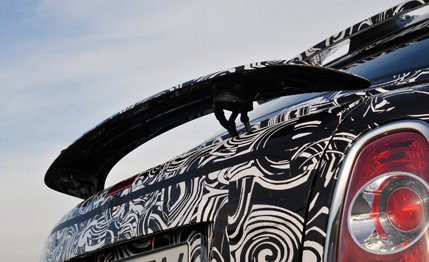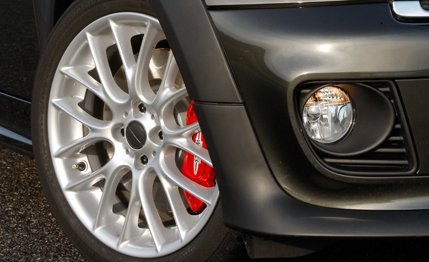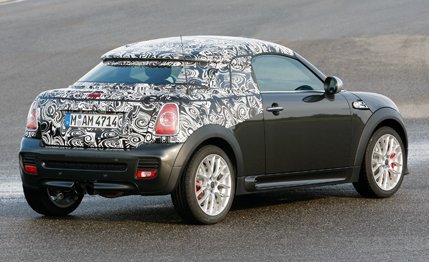
 Prototype Drive
Prototype Drive
“With a car like this,” Rauno Aaltonen says, “sportier is a bad word, because the extreme, if you take it too far, would be wipers on the side screens.”
Aaltonen knows from side-screen wipers. Here we have one of the world’s great rally drivers—an original Flying Finn, a spry 73-year-old former champion who has spent much of his working life on dirt. He is standing at a paved track in Austria, referring to the prototype Mini John Cooper Works coupe we’re here to drive. He is cautioning us against wanting too much.
Good advice, but with the coupe’s looks, much is promised. The Mini JCW coupe—and that’s what we’ll call it, because “Mini John Cooper Works coupe” just sounds all Anglophile Rain Man—is a two-seat, fixed-roof version of the Mini Cooper hatchback. It shares a platform with the current Mini convertible and upcoming Mini roadster, and it’s intended to round out the brand’s lineup in a flashy, attention-getting fashion. It is not—not, insist Mini marketing people—supposed to be the fastest or the most hard-core dog in the litter. Which is kind of confusing, given that it looks the part.
The premise is simple. British tuners like Broadspeed and Universal Power built two-place, Mini-based funsters in the 1960s, so the coupe has historical precedent. To keep costs down, the convertible’s unibody was essentially ported over. The coupe gains steel reinforcements in the sills and trunk but is otherwise a convertible from the beltline down. The windshield angle drops by 13 degrees, and a helmet-like steel roof has been welded over the cockpit, complete with a long trunklid and two spoilers. The rearmost spoiler is active, rising automatically at 50 mph and producing a claimed 88 pounds of downforce.


The rest is details. Driveline choices are unchanged from the rest of the Mini lineup, which is to say, everything from ordinary (122-hp Cooper) to feisty (208-hp John Cooper Works). Europe gets a 143-hp diesel four that Americans will never, ever see. All coupes come standard with a six-speed manual. Cooper and Cooper S buyers can opt for a six-speed automatic. The suspension geometry, the wheelbase, the wheel choices—almost everything else is standard-issue Mini.
Given the ordinary Mini’s chassis talent, that isn’t necessarily a bad thing. The big surprise is weight. The coupe is about 55 pounds porkier than a standard Mini hatch, thanks partly to the chassis reinforcements and active spoiler. (The latter alone adds 12 pounds.) This is a trivial bump, but if you’re giving up a rear seat, you should gain lightness, not lose it. Thanks to the new windshield, height falls by about an inch, to 54.5 inches. A whopping 10 cubic feet of cargo can fit underneath the trunklid, more if you take advantage of the standard pass-through between the two seats.
From the cockpit, the coupe doesn’t seem that different. The low roofline is annoying only when you look out the side windows and feel like Dumb Donald from the Fat Albert series, eyes up under your hat. The standard, cave-like black headliner and the dinky glass area keep the rearview mirror from telling you much. All the familiar brand cues are present, including the dash-mounted toggle switches and that ridiculous pizza-sized central speedometer.


Surprisingly, the coupe’s charms lie at speed. Our Austrian seat time was limited to John Cooper Works models, only on a smooth track, and only in the dry. In that idyllic environment, everything worked. The John Cooper Works four is a torquey symphony of farts, fizzes, and pops, a candy-coated gem of an engine. The cockpit isn’t too noisy, and wind noise isn’t excessive. With stability control on, this coupe reminds you of other Minis—talkative steering, taut body motions, progressive brake and clutch feel.
Turn off the stability control, however, and all hell breaks loose. Freed from the bonds of computer-managed balance, the JCW giddily backs itself into corners, chucking its ass out at the slightest rough turn-in or throttle lift. Inside wheelspin is everywhere, understeer only present if you abuse the gas with too much steering cranked in. It’s wonderful. This is what you thought front-drive cars were like when you were five years old: small, manic, and desperately in need of, to quote Aaltonen, side-screen wipers. And it’s one step crazier than the rest of the Mini lineup.
Wait, what?
When pressed, Mini staff admit that the coupe’s suspension tuning might differ from that of the hatch. They are not overly forthcoming on this point, only hinting that the damping is a bit stiffer and that the base Cooper coupe wears the 18-mm rear anti-roll bar from a Cooper S hatchback. “With the coupe,” says Mini engineer Heinz Krusche, “we tried to overcome the additional weight, to make the car as agile as the hatch. But at the moment”—he hesitates, as if unsure whether or not to continue—“it looks like we are perhaps a little bit more agile.”


We asked if the car would be detuned for production, maybe for the sake of ride quality and to match the tamer handling of its brethren. No answer. It’s all wonderfully suspicious, as if the boys in engineering were trying to pull a fast one on the rest of the company. If so, bully for them. A car that looks like this should drive this nutty.
About that: Buy a Mini coupe, people are going to gawp. The styling is divisive—this is an in-your-face, impractical version of an otherwise sensible machine, and it’s rife with contradiction. It’s targeted at masculine buyers but looks about as butch as a pink summer hat. It may or may not end up feeling sportier than its siblings. And although it’d be nice if the prototype’s giddy handling sees the showroom, that might not be appreciated by those who buy the car for its looks.
Our hosts in Austria didn’t seem bothered by this, but perhaps that’s intentional. As on most prototype drives, we weren’t given a lot of straight answers. Except from Aaltonen. He likes it sideways. Go figure.
Update: This version of the story corrects a typographical error in estimated curb weight and changes the estimated base price to the actual figure.

